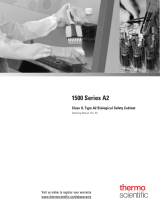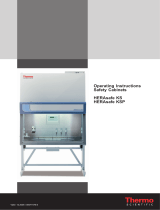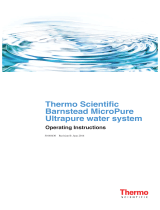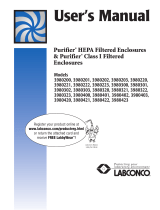Page is loading ...

Operating Instructions
Biological Safety Cabinet
MSC-Advantage™
Valid: 04.08.2022 / 50128856 D

© Copyright 2022
These operating instructions are protected by copyright. Rights resulting thereof, particularly reprint, photomechanical or
digital postprocessing or reproduction, even in part, are only allowed with the written consent of Thermo Electron LED
GmbH.
This regulation does not apply to reproductions for in-plant use.
Trademarks
MSC Advantage™, SmartFlow™ and SmartClean™ are registered trademarks of Thermo Scientific.
Thermo Scientific is a brand of Thermo Fisher Scientific Inc.
All other trademarks mentioned in the operating instructions are the exclusive property of the respective manufacturers.
Thermo Electron LED GmbH
Robert-Bosch-Straße 1
D - 63505 Langenselbold
Germany
The Thermo Electron LED GmbH is a subsidiary from:
Thermo Fisher Scientific Inc.
81 Wyman Street
Waltham, MA 02454
USA

1
Contents
Chapter 1 General Notes........................................................................................1
Data of the MSC-Advantage and the documentation ...........................2
Instruction of the operating personnel.................................................2
Applicability of the instructions...........................................................3
Warranty ..........................................................................................3
Standards and safety regulations .......................................................3
Explanation of symbols......................................................................4
Symbols used in the operating instructions ....................................4
Symbols on the Device .................................................................5
Use of the device ..............................................................................6
Correct use .................................................................................6
Incorrect use ...............................................................................6
Chapter 2 Delivery .................................................................................................7
Scope of delivery ..............................................................................7
Acceptance inspection ......................................................................7
Transport security lock and device packaging .....................................7
Chapter 3 Installation.............................................................................................8
Ambient conditions ...........................................................................8
Room ventilation ...............................................................................9
Correct location ................................................................................10
Installation in series ..........................................................................10
Transport .........................................................................................11
Chapter 4 Description of the Device ......................................................................13
Overall view......................................................................................13
Safety system...................................................................................14
Filter system.....................................................................................16
Operating and display elements .........................................................18
Sample chamber access ...................................................................19
Device interfaces ..............................................................................20
Sample chamber illumination.............................................................22
UV lamp unit.....................................................................................23
Working area....................................................................................24
Chapter 5 Start-Up.................................................................................................25
Initial operation .................................................................................25
Installing the device and accessories..................................................25
Unlocking the transport protection......................................................27
Levelling the cabinet .........................................................................28
Power supply connection...................................................................28
Installation test .................................................................................30
Chapter 6 Handling and Control.............................................................................31
Operating panel ................................................................................31
Functional units ...........................................................................31

Operating Instructions Biological Safety Cabinet | MSC-Advantage |
2
Display during calibration routine ..................................................32
Display during UV disinfection .......................................................33
Failure messages .........................................................................33
Device start-up.................................................................................33
Description of the operating modes....................................................34
Chapter 7 Operation...............................................................................................36
Hygiene preparations for the sample chamber ....................................36
Loading the sample chamber ............................................................36
Response to failure messages ...........................................................36
Work rules........................................................................................37
Chapter 8 Shut-Down ............................................................................................39
Interrupting an operation ...................................................................39
Shutting the device down ..................................................................39
Chapter 9 Cleaning and Decontamination .............................................................40
Decontamination procedure...............................................................40
Wipe/spray disinfection .....................................................................40
UV disinfection after a wipe/spray disinfection ....................................42
UV disinfection using the integral UV lamp .....................................42
UV disinfection using a mobile UV device (optional) ........................42
Changing UV disinfection time ......................................................42
Disinfection with formaldehyde ..........................................................43
Cleaning the exterior surfaces ...........................................................43
Cleaning the front window .................................................................44
Cleaning the floorpan ........................................................................44
Cleaning the protective grid...............................................................45
Chapter 10 Maintenance .......................................................................................46
Inspection ........................................................................................46
Service.............................................................................................46
Sample chamber illumination .......................................................47
Optional UV lamps .......................................................................47
Retrofitting and repairs......................................................................48
Exchanging SmartPorts .....................................................................49
Chapter 11 Disposal ..............................................................................................50
Disposal procedure ...........................................................................50
Chapter 12 Technical Data ....................................................................................51
Chapter 13 Device Log...........................................................................................55
Chapter 14 Certificate of Decontamination ...........................................................56

1
Figures
Figure 1. Device arrangement in the operating room....................................... 10
Figure 2. Lift points ...................................................................................... 11
Figure 3. Overall view ................................................................................... 14
Figure 4. Filter system with downflow and exhaust air filter ............................. 17
Figure 5. Operating and display elements....................................................... 18
Figure 6. Sample chamber opening ............................................................... 19
Figure 7. Supply interfaces............................................................................ 21
Figure 8. UV lamp unit .................................................................................. 23
Figure 9. Working area on the workplate, armrests......................................... 24
Figure 10. Stand installation.......................................................................... 26
Figure 11. Unlocking the transport protection ................................................. 27
Figure 12. Operating panel............................................................................ 32
Figure 13. Display upon start-up ................................................................... 33
Figure 14. Sitting posture.............................................................................. 38
Figure 15. Protective grid segment ................................................................ 45
Figure 16. UV lamp replacement ................................................................... 48

1
Operating Instructions Biological Safety Cabinet | MSC-Advantage | Chapter 1
General Notes
The following are the addresses of the international Thermo Fisher Scientific Sales
Organisations.
Postal address Germany
Thermo Electron LED GmbH
Robert-Bosch-Straße 1
D - 63505 Langenselbold
Inquiries from Germany
Phone
Phone Sales 0800 1 536376
Phone Service 0800 1 112110
Fax Sales/Service 0800 1 112114
Email info.labequipment.de@thermofisher.com
Enquiries from Europe, Middle East and Africa
Phone + 49 (0) 6184 / 90-6940
Fax + 49 (0) 6184 / 90-6772
Email info.labequipment.de@thermofisher.com
Postal address USA
Thermo Fisher Scientific
275 Aiken Road
Asheville, NC 28804
USA
Enquiries from North America
Phone +1 800-879 7767
Fax +1 828-658 0363
Email info.labequipment.de@thermofisher.com
Enquiries from Latin America
Phone +1 828-658 2711
Fax +1 828-645 9466
Email info.labequipment.de@thermofisher.com
Enquiries from Asia Pacific
Phone +852-2711 3910
Fax +852-2711 3858
Email info.labequipment.de@thermofisher.com

| Operating Instructions Biological Safety Cabinet | MSC-Advantage |
2
Chapter 1
Data of the MSC-Advantage and the
documentation
Device identification
Device Name: Biological Safety Cabinet
Model: MSC - Advantage ™
Model lines: 0.9, 1.2, 1.5, 1.8
Model 1.2.from serial devices: 41070608
Model 1.8.from serial devices: 41070639
Assignment of the product documentation
User manual: 501268856
Availability: 04.2011
Certification and Quality Audit:
Conformity: CE conformity marking
Instruction of the operating personnel
These operating instructions describe the biological safety cabinet
MSC Advantage
and apply to the models MSC 0.9, 1.2, 1.5, 1.8.
The biological safety cabinet has been manufactured in keeping with the latest
technological developments and has been tested before delivery for its correct function. It
may, however, present potential hazards if it is not used according to the intended
purpose or outside of operating parameters. Therefore, the following procedures must
always be observed to prevent accidents:
The biological safety cabinet must be operated only by trained and authorized
personnel.
For any operation of this device, the operator must prepare clear and concise written
instructions in the language of the operating and cleaning personnel based on these
operating instructions, applicable safety data sheets, plant hygiene guidelines, and
technical regulations, in particular:
which decontamination measures are to be applied for the cabinet and
accessories,
which protective measures apply while specific agents are used,
which measures are to be taken in the case of an accident.
Repairs to the device must be carried out only by trained and authorized expert
personnel.

3
Operating Instructions Biological Safety Cabinet | MSC-Advantage | Chapter 1
Applicability of the instructions
The contents of the operating instructions are subject to change without further
notice.
Concerning translations into foreign languages, the German version of these
operating instructions is binding.
Keep these operating instructions close to the device so that safety instructions and
important information are always accessible.
Should you encounter problems that are not detailed adequately in these operating
instructions, please contact Thermo Fisher Scientific immediately for your own safety.
Warranty
Thermo Fisher Scientific warrants the operational safety and functions of the biological
safety cabinet only under the condition that:
the device is operated and serviced exclusively in accordance with its intended
purpose and as described in these operating instructions,
the device is not modified,
only original spare parts and accessories that have been approved by Thermo Fisher
Scientific are used,
inspections and maintenance are performed at the specified intervals,
an installation test is performed prior to the initial operation of the device and that a
repeat test is performed on the occasion of all inspections and repairs.
The warranty is valid from the date of delivery of the device to the operator.
Standards and safety regulations
The device complies with the safety requirements of the following standards and
directives:
EN 12469
NF 095 Rev3.2006 / NF - Postes de Sécurité Microbiologique
IEC 61010-1
EN 61010-1
EN 12469
DIN EN 61326-1
Low Voltage Directive 2006/95 EG
EMC Directive 2004/108 EG
For the setting-up and installation of the biological safety cabinet the respective national
regulations must be observed.

| Operating Instructions Biological Safety Cabinet | MSC-Advantage |
4
Chapter 1
Explanation of symbols
Symbols used in the operating instructions
is used if non-observance may cause serious or even lethal injuries.
is used if non-observance may cause medium to minor injuries or damage.
NOTE
is used for hints and useful information.
Valuable raw materials can be reused.
Warning against electric shock.

5
Operating Instructions Biological Safety Cabinet | MSC-Advantage | Chapter 1
Symbols on the Device
Observe operating instructions (switchbox ceiling)
Warning against hand injuries (device side walls)
Biohazard (left front section of device)
CE Conformity declaration
Checked safety (cover light dome)
Norme Française / NF - Postes de Sécurité Microbiologique
T5A note (sample chamber fusing)
USB interface (top side of plenum panel)
Installation of the armrests (right side of the light hood)
Protective Earthing
USB

| Operating Instructions Biological Safety Cabinet | MSC-Advantage |
6
Chapter 1
Use of the device
Correct use
The Biological Safety Cabinet is a laboratory device for installation and operation in
microbiological and biotechnical laboratories of safety levels 1, 2, and 3. It has been
designed as a Class II microbiological biological safety cabinet, in accordance with EN
12469. According to EN 12469, the operation of the safety cabinet is only permitted for a
single user.
Depending on the hazard level of the agents involved, the operator must prepare in writing
appropriate decontamination procedures for the device and the accessories used in the
sample chamber.
Prior to the initial operation of the cabinet, the operator must perform an installation test.
The test result must be documented by a test report. The cabinet must only be released
for operation if it is in compliance with the operating parameters specified by Thermo
Fisher Scientific.
After any changes to the installation conditions and after any modification to the technical
system, a repeat test must be performed and the test result must be documented by a
test report that shows that all operating parameters are in compliance with those
specified by Thermo Fisher Scientific.
Incorrect use
The biological safety cabinet must not be used in laboratories that do not comply with the
requirements of safety levels 1, 2 or 3.
The device must not be operated as a Class II biological safety cabinet if:
no repeat test is performed after changes to the installation conditions or after
modifications to the technical system,
the alarm system of the device has issued a failure message and the cause for the
failure has not been repaired.
The alarm system must not be tampered with or disabled. If alarm system components
have been removed or disabled for service or repairs, the device must only be released for
operation if all alarm system components are functioning properly again.
The filters installed in the device are not capable of separating gaseous substances.
Therefore, never store or process gases or gas-releasing substances in the device:
which in quantity or concentration are toxic,
if a reaction with other substances may result in hazardous toxic concentrations or
formation of toxic gases,
that may form combustible or explosive mixtures in combination with air.

7
Operating Instructions Biological Safety Cabinet | MSC-Advantage | Chapter 2
Delivery
Scope of delivery
Delivery for the biological safety cabinet includes the following:
biological safety cabinet (without stand)
armrests
device documentation:
operating instructions
factory test report
Optional components and accessories are listed as separate items in the delivery
document.
Acceptance inspection
After the device has been delivered, immediately check the device:
for completeness,
for possible damage.
If the delivery is incomplete or if you detect any transport damage to the device,
contact the forwarding agency and Thermo Fisher Scientific immediately.
Transport security lock and device packaging
A transport security lock protects the device counterweight during transport. Protective
packagings protect the floorpan, the front window, and the workplate segments. To
remove the transport security lock and the protective packagings, please refer to the
enclosed installation instructions and to Sections 5.2 and 5.3 of these instructions.

8
Operating Instructions Biological Safety Cabinet | MSC-Advantage | Chapter 3
Installation
Ambient conditions
The operational safety and correct function of the device depends on the location where it
is to be operated. The biological safety cabinet must be operated only at locations that
meet the ambient conditions listed below.
Location requirements:
The electrical system of the device has been designed for an operating height of up
to 2000 m above sea level.
The mains power supply outlet should be out of casual reach to prevent accidental
shut-off. Ideally, the outlet should be installed above the safety cabinet.
The outlet must be accessible to authorized personnel only. It constitutes, together
with the power cable plug, the disconnection device for all poles.
The flooring of the location must be adequately strong and not flammable.
The stand must ensure a sufficient load-bearing capacity (twice the device weight).
The room in which the device is installed must be of adequate height. For devices
that are not connected to an exhaust system, the distance between the exhaust air
opening at the device ceiling and the room ceiling must be at least 200 mm (8 in).
The location must be equipped with an appropriate ventilation system (see section
“Room ventilation” on page 9).
For the valves may be installed a lateral distance of at least 300 mm is required to
ensure accessibility for the installation, see chapter “Device interfaces” on page 20.
The temperature within the room must be between 15 °C and 40 °C (49 °F and
104 °F).
The relative humidity in the vicinity of the device must not exceed 90 %.
NOTE Ambient conditions!
If ambient conditions vary from those described above, please contact Thermo
Fisher Scientific for assistance in installing the device.
NOTE Temporary storage!
If the device is stored only temporarily (up to four weeks), the ambient
temperature may be between -20 °C and +60 °C (-4 °F and +140 °F) at a
relative air humidity of up to 90 %. For longer storage periods, the location
requirements apply.
NOTE
Regional earthquake safety regulations must be observed.

| Operating Instructions Biological Safety Cabinet | MSC-Advantage |
9
Chapter 3
Room ventilation
The room ventilation should preferably be a ventilation system that complies with the
national requirements for the application.
The inlet air and exhaust air openings of the room ventilation must be located so that
drafts are prevented from impairing the function of the safety cabinet air system.
Coupling to laboratory exhaust systems
Coupling biological safety cabinets to a laboratory exhaust system, air that spills of
biological agents must be discharged to prevent inflow to the installation space. The
ventilation system of the biological safety cabinet itself are not to be influenced.
If a coupling to a laboratory exhaust system is installed, it must be ensured that no
harmful air flow is created in the installation space. The volume of air discharged by the
exhaust system must be tracked accordingly into the installation space. It should be
noted, that the equipment air flow itself is not affected.
The on site exhaust system should be dimensioned, so the air velocity scale in the draft
interrupter and exhaust air plenum is sufficient, that the equipment exhaust air has no air
resistance.
In states, where the coupling to a laboratory exhaust system is regulated by further
provisions, the relevant national regulations must be observed.
CAUTION – Installation test!
During the initial start-up of the biological safety cabinet an initial installation test must
be performed.
The installation location of the biological safety cabinet with connection to a technical
ventilation or with a coupling to laboratory exhaust system and additional installed
exhaust accessories are not to be changed.
Every modification of the installation location requires a new installation test (see chapter
“Installation test” on page 30)!

10
Operating Instructions Biological Safety Cabinet | MSC-Advantage | Chapter 3
Correct location
Choose a draft-free location where the biological safety cabinet does not interfere with the
plant traffic.
Fig. 1: This figure shows preferred locations for biological safety cabinets and unsuitable
locations that are not in accordance with the safety requirements.
Unsuitable locations: The locations [1], [2], and [3] are not suitable because they are
exposed to drafts from windows and doors.
Location [5] is unsuitable because it is within range of plant traffic and within the exhaust
air range of a ventilation system [4].
Preferred locations: The locations [6], [7], and [8] are correct because they are in a
draft-free section of the room and not exposed to plant traffic.
A counterweight at the device backpanel moves synchronously with the vertical
movement of the front window. To prevent the counterweight from jamming, the device
backpanel should be as close to the wall as possible.
Figure 1. Device arrangement in the operating room
Installation in series
When several devices are to be installed in series, please observe the following:
Make sure that vibrations cannot be transferred between adjacent devices.
Exterior surfaces of the cabinets must always be accessible for cleaning and
disinfection.
312
687
5
4

| Operating Instructions Biological Safety Cabinet | MSC-Advantage |
11
Chapter 3
Transport
Fig. 2: To prevent tilting, always transport the device using a suitable carrier, even for a
transport within a building.The device must be separated from the stand (see section
“Installing the device and accessories” on page 25).
Figure 2. Lift points
CAUTION – Tilting danger!
If the unit is tilted too much during lifting, risk of tipping exists. Lift the biological safety
cabinet only vertically!
For transportation (including inside buildings) use an appropriate lifting device, which
ensures that the unit:
• is on a stable stand and
• is secured against lateral tilting.
In combination with a floorstand it's not allowed to move the device.
When using the castor floorstand (optional):
Use only on smooth floors within a room and do not drive on landings or edges.

12
Operating Instructions Biological Safety Cabinet | MSC-Advantage | Chapter 3
CAUTION – Lift points!
For transport, lift the device only at the lift points shown in Figure 2.
Do not allow the weight of the cabinet to rest on the floorpan!
• Install the four lock screws (see section “Unlocking the transport protection” on
page 27).
CAUTION – Crushing hazard!
The weight of the front window is counterbalanced by the counterweight (at the rear of
the device).
The device must not be transported unless the counterweight has been locked.

13
Operating Instructions Biological Safety Cabinet | MSC-Advantage | Chapter 4
Description of the Device
Overall view
Fig. 3: Plenum assembly [3] with plenum for downflow blower [19] and plenum for
exhaust air blower [20]. The downflow filter and the exhaust air filter are installed
immediately to the pertaining plenum. The exhaust air is discharged to the exterior of
the device through an opening.
The plenum assembly is concealed behind a cover [18].
Switchbox [2] with power supply unit and power supply cable [1]. The top of the
device contains an USB connection [23] for a PC and two fuse holders [22].
Light dome [4] for the sample chamber illumination unit, equipped with one
fluorescent tube (model MSC 1.2) or two fluorescent tubes (model MSC 0.9, 1.5,
1.8).
The optional, device-integral UV lamp is installed to the ceiling at the front section of
the sample chamber.
Operating panel [5] with function keys and indicators.
Front window [7] with two handles [6].
Bushings [8] and [9] in the side panels (3 on each side). The bushings [9] can be
used to install media valves [11], the bushings [8] of type SmartPort are provided for
laying cables or hoses into the utility chamber.
Stand [10] (optional).
Workplate segments [13] with 2 armrests [14]. A one-piece workplate and special
workplates are available as optional accessories.
Internal outlets [15] for the power supply of accessories (optionally, one of the outlets
can be equipped with an adapter [17] for mobile UV devices).
Test hoses for the downflow unit [16] at the left side of the sample chamber and for
the exhaust air unit [12] at the right side of the sample chamber.
NOTE Test hoses!
Do not remove the caps of the two test hoses for checking downflow and
exhaust air.

| Operating Instructions Biological Safety Cabinet | MSC-Advantage |
14
Chapter 4
Figure 3. Overall view
Safety system
The safety system comprises a combination of protective and alarm systems that ensure
maximum personal and material protection.
Safety systems:
Vacuum-sealed air system
A vacuum-sealed air system in combination with HEPA filters for downflow and
exhaust air forms the basis of the safety system for personal and material protection.
Personal protection
Air aspired from the exterior along the entire working opening at a constant high
velocity prevents:
agents leaking through the working opening of the chamber.
As the exterior air pressure around the device exceeds the pressure of the internal air
system (vacuum sealing), it ensures:

15
Operating Instructions Biological Safety Cabinet | MSC-Advantage | Chapter 4
agents cannot be released to the exterior in the case of a leak in the cabinet
housing.
Material protection
A steady airflow within the air system ensures:
a constant downflow allowing the HEPA filters to remove contaminants so that
the samples are always surrounded by ultrapure air,
harmful particles are not carried over through the sample chamber (protection
from cross-contamination).
HEPA filters
The downflow (i.e. the air circulating within the device) and the exhaust air (air that is
released to the exterior) are cleaned by HEPA filters (HEPA = High Efficiency
Particulate Air Filter).
Safety lockout
To protect from UV radiation, the optional UV disinfection routine can be run only if
the front opening is closed. During UV disinfection, the front opening safety lockout is
activated and prevents harmful UV radiation from being emitted from the sample
chamber.
Circuits can be driven via potential-free contacts (monitor contacts), e.g. a solenoid
that switches automatically upon cancellation of the work mode.
Safety during UV decontamination routine:
Blue light during UV decontamination routine
To visualize that the UV decontamination routine is in process, parallel to the UV
radiation is blue light visible. The intensity and wavelength of the blue light does not
harm users and environment, never the less it is recommended that a direct looking
inside should not be done.
UV decontamination
The UV decontamination routine is using exclusively the radiation wavelength of 254
nm for decontamination. Wavelengths of 254 nm are classified in the UV radiation
group UV-C, and is according to the literature the most efficient radiation for
decontamination. 254 nm radiation is not and cannot pass metal sheets, glass
(windows) or woven fabrics. By respecting Use of the device (see section “Use of the
device” on page 6) and the safety level, no risk for the user or the environment is
expected. Never the less it is recommended that a direct exposing of unprotected
skin or eyes should not be done.
Warning system:
Airflow monitoring
Airflow monitoring determines the velocity of the airflow in the sample chamber as
well as the inflow velocity of the air aspired from the exterior through the working
opening. As soon as airflow velocities move above or below a specified safety value,
a signal is transmitted to the alarm system.
Visual and audible alarm system
The warning system constantly monitors the safety-relevant device functions:
Inflow velocity of the air aspired from the exterior,
/














